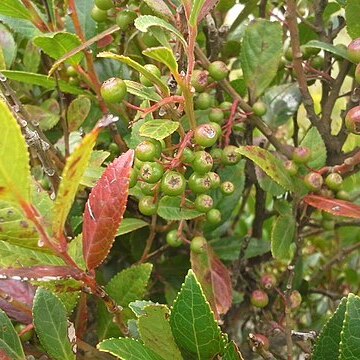A shrub or small tree. It grows 2-4 m high. It can be 7 m high. The bark is light brown. The leaves are simple and alternate. They are oval and 4-6 cm long by 1-2 cm wide. They are leathery. They are green above and blue-green below. The edges are toothed. The leaf stalk is 5 mm long. The flowers are greenish or creamy-white. They are bell-shaped and 7 mm long. They occur in sprays in the axils of leaves. These are 4 cm long. The fruit are almost round and 7 mm across. They are red and become black when mature. The calyx forms a crown at the end.
Leaves alternate, narrowly ovate, acuminate, glandular serrate, 25–65 mm. long, 10–25 mm. broad, glabrous or sometimes with hairs on the basal part of the midrib on the ventral surface of the leaf; petioles glabrous or sometimes sparsely pubescent, 2–5 mm. long.
Pedicels glabrous, 3–7 mm. long in flower, extending to 8–13 mm. in fruit, and bearing two opposite bracteoles near the base; bracteoles leaf–like to narrow and membranous, 2–3 mm. long.
Stamens 8–10, included; filaments pubescent above, 2 mm. long; anthers versatile, puberulous, 3·0–3·5 mm. long, opening by pores at the apex of two long horns, without appendages.
Corolla 5–lobed, white or pink, obconical to narrowly urceolate, 5–6·5 mm. long, 3–4·5 mm. broad, lobes imbricate, obtuse, c. 1 mm. long, sinuses acute.
Small tree or shrub, up to 2 m high. Leaves alternate, simple, elliptic, coriaceous, margins regularly serrate. Flowers Erica-like, white.
Sepals 5, free, insertedd at the top of the ovary, triangular, acute, glabrous, c. 1·2 mm. long, c. 1·5 mm. broad.
Inflorescence consisting of axillary racemes, peduncles glabrous, 15–20–flowered, up to 80 mm. long.
Flowers subtended by caducous leaf–like bracts, to 15 mm. long but usually considerably smaller.
Branchlets glabrous, minutely puberulous, or occasionally sparsely pubescent.
Style included, 4–5·5 mm. long, not swollen above, shed in fruit.
Shrubs to 5 m. tall but usually less, branched from the base.
Fruit a red berry, 5–8 mm. in diameter.
Ovary glabrous.

